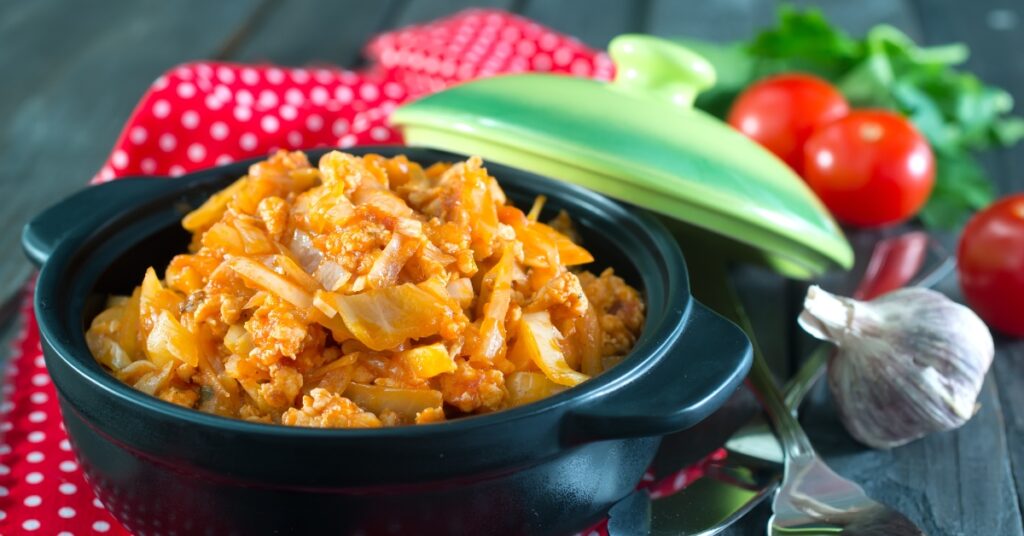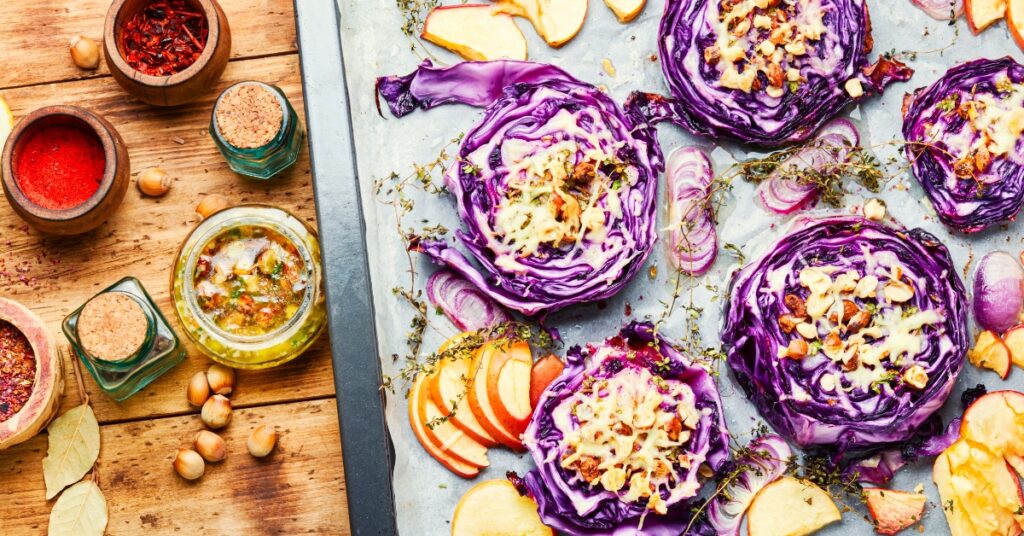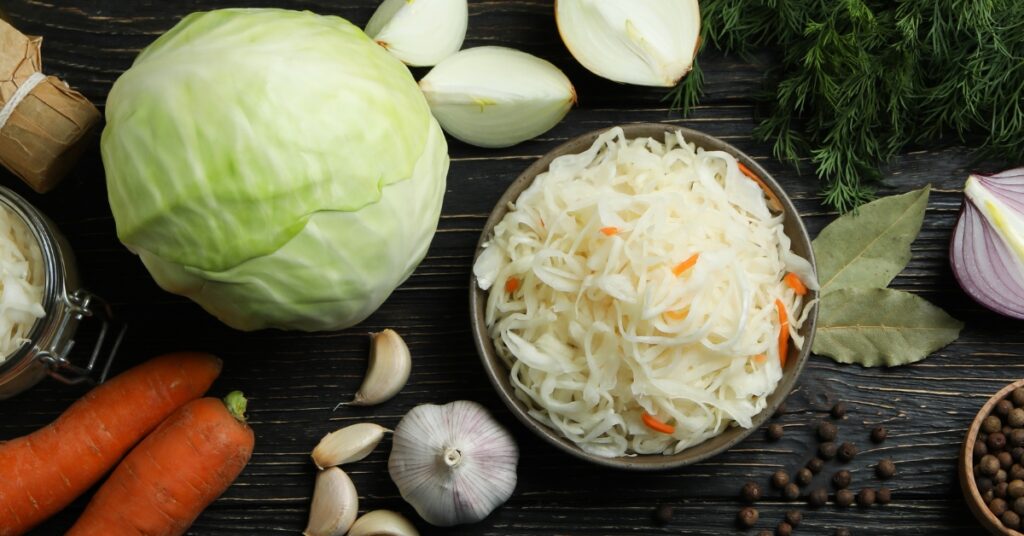Soul food is so much more than a cooking tradition; it’s a celebration of neighborhood, culture, and history. Among its numerous precious meals stands cabbage, a simple vegetable transformed into a flavorful, comforting, or black-eyed pea. This genuine Soul Food Cabbage Recipe is an easy yet deeply satisfying meal that will
Whether you’re an experienced cook or simply starting in the kitchen, this guide will take you through whatever you need to understand—from understanding cabbage’s deep cultural roots to tips for infusing every bite with flavor. By the end, you’ll be ready to whip up your emotional cabbage dish, ideal for events or a typical weekday dinner.

The History of Soul Food Cabbage and Its Cultural Significance
The Origins of Soul Food Cabbage Throughout slavery, oppressed Africans were provided scraps and leftovers from their servant owners’ meals. Through resourcefulness and imagination, they changed these components into scrumptious dishes that sustained them through hard times.
Cabbage was a popular veggie amongst enslaved people since it might be quickly grown in gardens and had a long life span. It also provided necessary nutrients for survival, making it a staple in their diets. As time passed and African Americans gained more liberty, cabbage continued to hold a special place in their cuisine.
Soul food cabbage ended up being implanted in African American culture as a symbol of durability and flexibility. It
Soul food originated in the Southern United States during slavery. It was created by enslaved African Americans who were frequently given unwanted and restricted ingredients to prepare. To make the most of what they had, they combined traditional African cooking methods with European active ingredients, resulting in tasty meals known as soul food.
Cabbage has been a staple in soul food for centuries and has deep cultural significance within the African American neighborhood. Throughout slavery, cabbage was easy to grow and readily offered, making it a common component in their diet plans.
Soul food cabbage has a rich history that traces back to the African American community throughout the times of slavery in America. It was produced out of necessity, as enslaved people were only provided scraps and leftovers from their masters’ cooking areas. With restricted resources, they had to be imaginative in making delicious and filling meals.
Cabbage was one of the few veggies readily available to enslaved people, and they used it to create a range of dishes. Soul food cabbage was particularly popular because of its hearty and soothing qualities, which provided nourishment to those who needed it most.
As time went on and slavery ended, soul food cabbage continued to be a staple in many African American households. It progressed
Soul food cabbage has actually long been a staple in Southern cooking. When oppressed African Americans utilized resourcefulness to develop scrumptious meals in spite of minimal ingredients, it came from throughout an era. Cabbage, a readily available and inexpensive veggie, became an essential component in numerous dishes, supplying nourishment and flavor when combined with pork, onions, and flavorings.
Throughout the years, soul food cabbage has developed while remaining a symbol of convenience and togetherness. Many families still prepare it the same way their grandparents did, passing down dishes as treasures. The smoky, savory taste of slow-cooked cabbage continues to stimulate memories of Sunday suppers and valued traditions.
If you’re ready to honor this ageless dish, here’s everything you’ll require to develop your very own soul food cabbage dish.
Active Ingredients for Authentic Soul Food Cabbage Recipe
- 1 head of green cabbage
- 6 slices of thick-cut bacon
- 1 yellow onion, diced
- 2 cloves of garlic, minced
- 1 tablespoon of apple cider vinegar
- Salt and pepper to taste
Traditional Cooking Method for Soul Food Cabbage Recipe
- Begin by washing the green cabbage and eliminating any damaged outer leaves.
- Begin by removing the outer leaves of the cabbage and slicing it into wedges.
- Begin by cleaning the cabbage and removing any damaged external leaves.
- Cut the cabbage into quarters and remove the core.
- Slice each quarter into thin strips.
- In a big pot or Dutch oven, cook the bacon over medium heat till crispy.
- Please remove the bacon from the pot and reserve it on a paper towel-lined plate to drain excess grease.
- In a large pot or Dutch oven, cook the bacon over medium heat till crispy.
- Remove the cooked bacon from the pot and set it aside on a paper towel to drain pipes.
- Include diced onion and minced garlic in the hot bacon grease in the pot.
- Prepare up until onions are translucent, stirring sometimes.
- Include sliced-up cabbage wedges, stirring to coat them in the bacon grease.
- Cover the pot with a cover and let it prepare for 10 minutes, stirring occasionally.
- After 10 minutes, stir and get rid of the cover in apple cider vinegar
- Cut the cabbage into quarters, remove the core, and slice each quarter into thin shreds.
- In a big pot or Dutch oven, cook the bacon over medium-high heat till crispy.
- Remove the bacon from the pot and reserve it on a paper towel to drain the pipes’ excess grease.
- Add diced onions and minced garlic to the same pot with the remaining bacon fat. Prepare until slightly transparent and fragrant.
- Toss in the shredded cabbage and stir well to coat it equally with the onion and garlic mix.
- Cover the pot with a cover and let it prepare for 10

6
To create the best soul food cabbage dish, you do not need a long list of elegant ingredients. Simplicity is key. However, every item plays a vital role in accomplishing that standard flavor.
Ingredients:
- 1 medium head of green cabbage (about 2.5-3 pounds), approximately sliced
- 5 pieces of thick-cut bacon, sliced (or smoked turkey for a lighter choice).
- 1 medium onion, finely chopped.
- 3 garlic cloves, minced.
- 1 teaspoon smoked paprika (adds a rich, smoky depth of taste).
- 1/2 teaspoon red pepper flakes (optional, for a bit of heat).
- 1 cup chicken stock (or veggie stock for a vegetarian choice).
- Salt and black pepper, to taste.
- 2 tablespoons olive oil or butter for cooking.
Substitution Tips:
- If you choose a vegetarian choice, you can substitute the bacon with smoked tempeh or tofu. They will still provide a smoky taste to the meal.
- If you’re avoiding pork, smoked turkey or turkey bacon works beautifully to supply that same mouthwatering, smoky flavor.
- Adverse garlic or onions? Use onion and garlic powder as substitutes while still keeping some taste aspects.
- Desire to make it vegetarian? Swap the chicken stock for veggie stock and remove the meat.
- For a gluten-free variation, use gluten-free pasta and guarantee that your chicken or veggie stock is also gluten-free.
- If you don’t have any smoked paprika on hand, regular paprika will work just fine. You can likewise add a little liquid smoke to achieve the very same smoky flavor.
- Do you desire more protein in your dish? Add some prepared shredded chicken or canned beans.
- To make this dish dairy-free, leave out the butter and use olive oil instead. You can also skip the.
Now that you have your ingredients ready, it’s time to begin cooking!
Step-by-step Instructions for an Authentic Experience:
- Start by heating a large pot or Dutch oven over medium-high heat.
- Add your option of meat and cook until browned about 5-7 minutes.
- When the meat is cooked, eliminate it from the pot and set aside.
- In the same pot, add your sliced vegetables (onion, celery, peppers) and diced garlic. Cook for about 5 minutes until they become aromatic and soft.
- Return the meat to the pot and stir whatever together.
- Gather your choice of broth or stock (chicken or vegetable) and give it a boil.
- When boiling, lower the heat to low.
Step 1:.
- Warm a big pot or Dutch oven over medium-high heat. Add the diced bacon and cook until crispy.
- Remove the bacon from the pot and set it aside on a plate lined with paper towels to drain excess grease.
Action 2:.
- Leave about two tablespoons of bacon fat in the pot and add the diced aromatics (onion, celery, and carrots). Sauté for about 5 minutes until they begin to soften.
- Next, include minced garlic, thyme, bay leaves, salt, pepper, and red pepper flakes (if utilized). Cook for an extra minute until fragrant.
Action 3:.
- Add in.
- Begin by warming up a large pot or Dutch oven over medium-high heat.
- As soon as the pot is hot, include your choice of oil (olive, vegetable, canola) and let it warm up for about 30 seconds.
- Include your diced onions and sauté for about 2-3 minutes till they become clear.
- Next, add in your minced garlic and cook for another minute until aromatic.
- Now it’s time to add your meat option (if you are using it). Cook up until browned, stirring periodically.
- Gather your chicken stock (or vegetable stock), followed by your collard greens. Stir everything together.
This dish takes about 40 minutes from start to finish, and every action adds to delivering a meal soaked in flavor and credibility.

Action 1: Prepare your active ingredients.
- Slice the cabbage into medium-sized pieces, discarding the core. Rinse and reserve.
- Dice the bacon and carefully slice the onion and garlic.
Step 2: Cook the bacon.
- Heat a large skillet or Dutch oven over medium heat. Add the sliced bacon and cook until crispy.
- Remove the bacon and set aside, leaving the rendered fat in the pan.
Action 3: Sauté the vegetables.
- Include the olive oil or butter in the rendered bacon fat. Toss in the sliced onion and garlic. Sauté for 3-4 minutes until soft and aromatic.
Step 4: Season and prepare the cabbage.
- Slowly include the cabbage in the skillet, stirring to coat it in the onion-garlic mix. If needed, don’t overcrowd the pan; work in batches.
- Sprinkle in the smoked paprika, red pepper flakes (if using), salt, and black pepper. Mix well to disperse the seasonings evenly.
Step 5: Add liquid and simmer.
- Gather the chicken stock and bring the mixture to a simmer. Reduce the heat to low, cover, and cook for 20-25 minutes, stirring periodically to ensure even cooking.
Step 6: Finish with bacon and serve.
- Once the cabbage is tender and has actually absorbed the taste, return the crispy bacon to the skillet and mix well. Taste and adjust the flavorings if required.
- Serve hot as a side meal, or enjoy it by itself for a comforting, hearty meal.

Expert Soul Food Cabbage Recipe Cooking Tips for Maximum Flavor.
- To spice up this dish, you can sprinkle in some red pepper flakes or add a dash of hot sauce while the cabbage is cooking. This will offer it a little kick without overpowering the other flavors.
- For added depth of flavor, utilize a combination of chicken and beef stock rather than simply chicken stock.
- For a vegetarian version, utilize and omit the bacon vegetable broth instead of chicken stock. Add some smoked paprika for a smoky flavor.
- For the finest results, use a cast iron frying pan. The pan’s even heat distribution and retention will help cook the cabbage uniformly and give it a great sear on the edges.
- Layer Your Seasoning: Season each element (the bacon, onions, and cabbage) as you cook to develop layers of taste.
- Don’t Overcook: Soul food cabbage must be tender but not mushy. Keep a close eye on it while simmering.
- Usage Cast Iron: A cast iron frying pan or Dutch oven maintains heat wonderfully and boosts the total depth of flavor.
- Try different types of bacon, such as applewood or maple-seasoned, to add depth of flavor to the dish.
- For an additional kick of spice, add red pepper hot sauce before serving.
- To make this meal vegetarian-friendly, alternative bacon with smoked paprika for a smoky flavor or caramelized onions for added sweetness.
- Do not be afraid to get imaginative and add other vegetables, such as carrots, mushrooms, or bell peppers, to make this dish more nutritious and vibrant.
- For a more indulgent meal, add some heavy cream or sour cream to the frying pan after adding the chicken stock. This will produce a velvety texture and add richness to the meal.
- Experiment with various types of cabbage, such as Napa cabbage or Savoy cabbage, for distinct flavors and textures.
- Including some diced potatoes or carrots can make this dish even heartier and more filling.
- To make this dish spicier, add in some red pepper flakes or a sliced jalapeno pepper while sautéing the onion and garlic.
- To make this meal vegetarian-friendly, use and omit the bacon veggie broth rather than chicken stock.
- Include some chopped apples or raisins for a touch of sweetness to cancel the tasty taste.
- For an extra kick, include a splash of apple cider vinegar or hot sauce before serving.
- This dish can be quickly made ahead of time and reheated for busy weeknights. Just shop in an airtight container in the fridge and reheat on the stovetop or in the microwave.
- For an extra layer of taste, you can also include some sliced onions and garlic at the beginning when sautéing the bacon. Prepare until they are softened and clear before adding in the cabbage.
- Don’t hesitate to try various kinds of cabbage for this dish. Savoy or Napa cabbage both work well and have multiple textures and flavors that can alter the meal.
- If you desire to make this meal vegetarian, leave it out.
Conclusion.
This velvety cabbage and bacon skillet is.
For those who like a little additional richness, you can sprinkle in a dash of apple cider vinegar or a touch of sugar to balance the taste. Trust us, your taste will thank you!
Nutritional Highlights of Cabbage.
Cabbage is a nutrient-dense veggie that is low in calories and high in fiber, making it a great addition to any diet. It is also packed with minerals and vitamins such as vitamin C, vitamin K, folate, potassium, and magnesium. Furthermore, cabbage includes antioxidants and has anti-inflammatory homes.
- Research studies have revealed that consuming cabbage, due to its antioxidant content, might help.
- The high fiber content in cabbage can aid in food digestion and promote a healthy gut microbiome.
- Its low-calorie count makes it an excellent alternative for those looking to lose or preserve weight.
Other Ways to Enjoy Cabbage.
- Raw: Add shredded cabbage to salads or use it as a base for homemade coleslaw.
- Roasted: Cut cabbage into wedges, drizzle with olive oil and your option of seasonings, and roast in the oven for a delicious side meal.
- Fermented: Make sauerkraut or kimchi utilizing cabbage for a probiotic-rich dressing.
- Stir-fry: Incorporate sliced cabbage into stir-fries for added texture and nutrients.
- Soup: Cabbage is a common component in numerous conventional soups, such as borsch or minestrone.
Conclusion.

In general, cabbage is flexible and nutritious in a range of ways. From roasted to fermented, many vary in cabbage. Try one of these recommended preparations, or get creative and come up with your special method to enjoy cabbage.
Cabbage is a highly healthy vegetable that offers numerous health advantages. Its adaptability makes.
Cabbage can be enjoyed in a range of methods, making it a flexible and scrumptious addition to any diet plan. Here are some ideas for incorporating more cabbage into your meals:
- Raw: Cabbage is frequently utilized as a crunchy addition to salads. You can shred it or chop it into bite-sized pieces and mix it with other vegetables, nuts, and dressings for a fresh and nutritious salad.
- Prepared: Cabbage can also be cooked using different methods, such as steaming, boiling, roasting, or sautéing. For added texture and nutrients, it can be included in stir-fries, soups, stews, or casseroles.
- Fermented: Sauerk.
If you can’t get enough of it.
Cabbage is not just delicious, but it likewise loads a nutritional punch! This modest vegetable is abundant in vitamins and minerals, making it a great addition to any meal. Here are some of the essential dietary highlights of cabbage:
- Fiber: Cabbage is high in fiber, which helps promote healthy digestion and keeps you feeling complete.
- Vitamin C: Just one cup of cabbage provides more than 50% of your day-to-day recommended consumption of vitamin C. This vitamin is vital for immune health and collagen production.
- Vitamin K: Cabbage likewise includes an excellent quantity of vitamin K, which contributes to blood clotting and bone health.
- ** Antioxidants.
Cabbage, a cruciferous vegetable, is abundant in nutrients and has numerous health advantages. It is low in calories yet high in fiber, making it an outstanding addition to any diet plan. Here are some of the dietary highlights of cabbage:
- Vitamin C: Cabbage is a terrific source of vitamin C, providing over 50% of the suggested day-to-day intake per serving.
- Folate: Folate is necessary for cell growth and advancement, and cabbage consists of a significant amount of this nutrient.
- Vitamin K: Cabbage is an excellent source of vitamin K.
- Antioxidants: Red cabbage.
Cabbage isn’t simply tasty; it’s likewise extremely healthy, making this recipe a win-win. Here are some crucial health advantages:
High in Vitamins: Rich in vitamins C and K, cabbage supports a healthy body, immune system, and bone health.
- Low Calories, High Fiber: Cabbage is low in calories and high in fiber, making it a fantastic option for maintaining a balanced diet.
- Heart-Healthy: The antioxidants in cabbage can help reduce inflammation and support total heart health.
When coupled with entire grains or lean proteins, your soul food cabbage dish becomes a well-rounded meal that both nurtures and delights.
Take Your Taste Buds on a Journey.
Now that you’ve mastered the art of cooking soul food cabbage, it’s time to roll up your sleeves and give it a shot. This dish isn’t just food for the body; it’s food for the soul. Whether you’re serving it for Sunday supper, a special household event, or simply a weeknight reward, it will bring heat, flavor, and a sense of togetherness to your table.
We’d love to hear all about your experience. Did you try any twists or alternatives? Please share your photos and ideas in the comments below or tag us on [Social Media Handle]
Among its many cherished dishes stands cabbage, a modest veggie transformed into a flavorful, reassuring, or black-eyed pea. The smoky, savory taste of slow-cooked cabbage continues to evoke memories of Sunday dinners and valued traditions.
Cabbage is a nutrient-dense veggie that is low in calories and high in fiber, making it an excellent addition to any diet plan. Here are some of the crucial dietary highlights of cabbage:
Now that you’ve mastered the art of cooking soul food cabbage, it’s time to roll up your sleeves and offer it a try.






